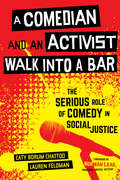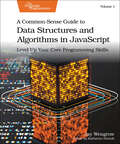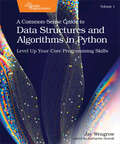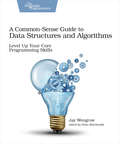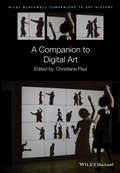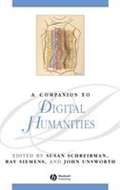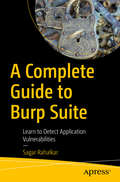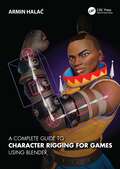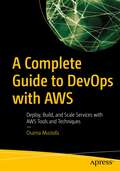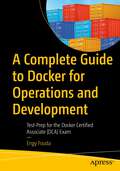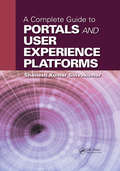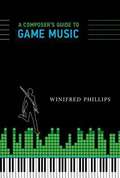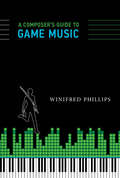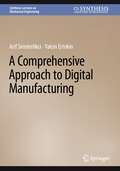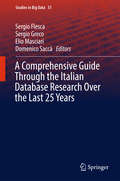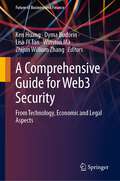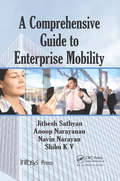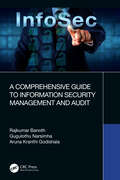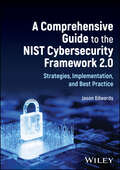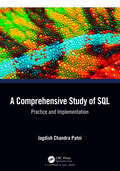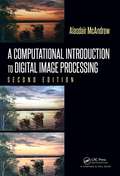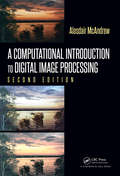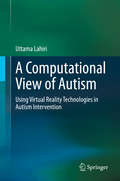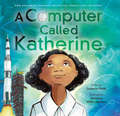- Table View
- List View
A Comedian and an Activist Walk into a Bar: The Serious Role of Comedy in Social Justice (Communication for Social Justice Activism #1)
by Lauren Feldman Caty Borum ChattooComedy is a powerful contemporary source of influence and information. In the still-evolving digital era, the opportunity to consume and share comedy has never been as available. And yet, despite its vast cultural imprint, comedy is a little-understood vehicle for serious public engagement in urgent social justice issues – even though humor offers frames of hope and optimism that can encourage participation in social problems. Moreover, in the midst of a merger of entertainment and news in the contemporary information ecology, and a decline in perceptions of trust in government and traditional media institutions, comedy may be a unique force for change in pressing social justice challenges. Comedians who say something serious about the world while they make us laugh are capable of mobilizing the masses, focusing a critical lens on injustices, and injecting hope and optimism into seemingly hopeless problems. By combining communication and social justice frameworks with contemporary comedy examples, authors Caty Borum Chattoo and Lauren Feldman show us how comedy can help to serve as a vehicle of change. Through rich case studies, audience research, and interviews with comedians and social justice leaders and strategists, A Comedian and an Activist Walk Into a Bar: The Serious Role of Comedy in Social Justice explains how comedy – both in the entertainment marketplace and as cultural strategy – can engage audiences with issues such as global poverty, climate change, immigration, and sexual assault, and how activists work with comedy to reach and empower publics in the networked, participatory digital media age.
A Common-Sense Guide to Data Structures and Algorithms in JavaScript, Volume 1: Level Up Your Core Programming Skills
by Jay WengrowIf you thought data structures and algorithms were all just theory, you're missing out on what they can do for your JavaScript code. Learn to use Big O notation to make your code run faster by orders of magnitude. Choose from data structures such as hash tables, trees, and graphs to increase your code's efficiency exponentially. With simple language and clear diagrams, this book makes this complex topic accessible, no matter your background. Every chapter features practice exercises to give you the hands-on information you need to master data structures and algorithms for your day-to-day work. Algorithms and data structures are much more than abstract concepts. Mastering them enables you to write code that runs faster and more efficiently, which is particularly important for today's web and mobile apps. Take a practical approach to data structures and algorithms, with techniques and real-world scenarios that you can use in your daily production code. The JavaScript edition uses JavaScript exclusively for all code examples, exercises, and solutions. Use Big O notation to measure and articulate the efficiency of your code, and modify your algorithm to make it faster. Find out how your choice of arrays, linked lists, and hash tables can dramatically affect the code you write. Use recursion to solve tricky problems and create algorithms that run exponentially faster than the alternatives. Dig into advanced data structures such as binary trees and graphs to help scale specialized applications such as social networks and mapping software. You'll even encounter a single keyword that can give your code a turbo boost. Practice your new skills with exercises in every chapter, along with detailed solutions. Use these techniques today to make your JavaScript code faster and more scalable. What You Need: Certain code examples take advantage of recently introduced JavaScript features. Therefore, it's important to use a JavaScript environment that supports ECMAScript 6+ or a newer version.
A Common-Sense Guide to Data Structures and Algorithms in Python, Volume 1: Level Up Your Core Programming Skills
by Jay Wengrowp>If you thought data structures and algorithms were all just theory, you're missing out on what they can do for your Python code. Learn to use Big O notation to make your code run faster by orders of magnitude. Choose from data structures such as hash tables, trees, and graphs to increase your code's efficiency exponentially. With simple language and clear diagrams, this book makes this complex topic accessible, no matter your background. Every chapter features practice exercises to give you the hands-on information you need to master data structures and algorithms for your day-to-day work.Algorithms and data structures are much more than abstract concepts. Mastering them enables you to write code that runs faster and more efficiently, which is particularly important for today's web and mobile apps. Take a practical approach to data structures and algorithms, with techniques and real-world scenarios that you can use in your daily production code. The Python edition uses Python exclusively for all code examples, exercise, and solutions.Use Big O notation to measure and articulate the efficiency of your code, and modify your algorithm to make it faster. Find out how your choice of arrays, linked lists, and hash tables can dramatically affect the code you write. Use recursion to solve tricky problems and create algorithms that run exponentially faster than the alternatives. Dig into advanced data structures such as binary trees and graphs to help scale specialized applications such as social networks and mapping software. You'll even encounter a single keyword that can give your code a turbo boost. Practice your new skills with exercises in every chapter, along with detailed solutions.Use these techniques today to make your Python code faster and more scalable.
A Common-Sense Guide to Data Structures and Algorithms, Second Edition: Level Up Your Core Programming Skills
by Jay WengrowAlgorithms and data structures are much more than abstract concepts. Mastering them enables you to write code that runs faster and more efficiently, which is particularly important for today’s web and mobile apps. Take a practical approach to data structures and algorithms, with techniques and real-world scenarios that you can use in your daily production code, with examples in JavaScript, Python, and Ruby. This new and revised second edition features new chapters on recursion, dynamic programming, and using Big O in your daily work. Use Big O notation to measure and articulate the efficiency of your code, and modify your algorithm to make it faster. Find out how your choice of arrays, linked lists, and hash tables can dramatically affect the code you write. Use recursion to solve tricky problems and create algorithms that run exponentially faster than the alternatives. Dig into advanced data structures such as binary trees and graphs to help scale specialized applications such as social networks and mapping software. You’ll even encounter a single keyword that can give your code a turbo boost. Practice your new skills with exercises in every chapter, along with detailed solutions. Use these techniques today to make your code faster and more scalable.
A Common-Sense Guide to Data Structures and Algorithms: Level Up Your Core Programming Skills
by Jay Wengrow"Algorithms and data structures are much more than abstract concepts. Mastering them enables you to write code that runs faster and more efficiently, which is particularly important for today’s web and mobile apps. This book takes a practical approach to data structures and algorithms, with techniques and real-world scenarios that you can use in your daily production code. Graphics and examples make these computer science concepts understandable and relevant. You can use these techniques with any language; examples in the book are in JavaScript, Python, and Ruby.Use Big O notation, the primary tool for evaluating algorithms, to measure and articulate the efficiency of your code, and modify your algorithm to make it faster. Find out how your choice of arrays, linked lists, and hash tables can dramatically affect the code you write. Use recursion to solve tricky problems and create algorithms that run exponentially faster than the alternatives. Dig into advanced data structures such as binary trees and graphs to help scale specialized applications such as social networks and mapping software. You’ll even encounter a single keyword that can give your code a turbo boost. Jay Wengrow brings to this book the key teaching practices he developed as a web development bootcamp founder and educator.Use these techniques today to make your code faster and more scalable."
A Companion to Digital Art
by Christiane PaulReflecting the dynamic creativity of its subject, this definitive guide spans the evolution, aesthetics, and practice of today s digital art, combining fresh, emerging perspectives with the nuanced insights of leading theorists. Showcases the critical and theoretical approaches in this fast-moving discipline Explores the history and evolution of digital art; its aesthetics and politics; as well as its often turbulent relationships with established institutions Provides a platform for the most influential voices shaping the current discourse surrounding digital art, combining fresh, emerging perspectives with the nuanced insights of leading theorists Tackles digital art s primary practical challenges how to present, document, and preserve pieces that could be erased forever by rapidly accelerating technological obsolescence Up-to-date, forward-looking, and critically reflective, this authoritative new collection is informed throughout by a deep appreciation of the technical intricacies of digital art
A Companion to Digital Humanities
by Susan Schreibman Ray Siemens John UnsworthThis Companion offers overview of the emerging field of humanities computing. Major sections focus on the experience of particular disciplines in applying computational methods to research problems; the basic principles of humanities computing and archiving.
A Complete Guide to Burp Suite: Learn to Detect Application Vulnerabilities
by Sagar RahalkarUse this comprehensive guide to learn the practical aspects of Burp Suite—from the basics to more advanced topics. The book goes beyond the standard OWASP Top 10 and also covers security testing of APIs and mobile apps. Burp Suite is a simple, yet powerful, tool used for application security testing. It is widely used for manual application security testing of web applications plus APIs and mobile apps. The book starts with the basics and shows you how to set up a testing environment. It covers basic building blocks and takes you on an in-depth tour of its various components such as intruder, repeater, decoder, comparer, and sequencer. It also takes you through other useful features such as infiltrator, collaborator, scanner, and extender. And it teaches you how to use Burp Suite for API and mobile app security testing.What You Will Learn Understand various components of Burp Suite Configure the tool for the most efficient use Exploit real-world web vulnerabilities using Burp Suite Extend the tool with useful add-onsWho This Book Is ForThose with a keen interest in web application security testing, API security testing, mobile application security testing, and bug bounty hunting; and quality analysis and development team members who are part of the secure Software Development Lifecycle (SDLC) and want to quickly determine application vulnerabilities using Burp Suite
A Complete Guide to Character Rigging for Games Using Blender
by Armin HalačThis book is a comprehensive guide to using Blender to create character rigs for games, breaking down the technicalities of rigging tools and techniques into easily digestible chunks. It provides all the tools needed to go from a static character model to an animation-ready, high quality, and fast performing game rig. Written to be accessible and easy to follow, the book covers character rigging theory that is supported by industry standard examples of how to apply that theory to character rigs for video games. It demonstrates the reasoning behind rigging decisions followed by instructions and examples on how to apply that knowledge to rig creation. It includes chapters that focus on the character deformation techniques that raise the visual quality of the model and subsequently of the animation and game it will be used in. This book will be vital reading to those studying games animation as well as early-career rigging artists, character animators, modeling artists, technical animators, and technical artists.
A Complete Guide to DevOps with AWS: Deploy, Build, and Scale Services with AWS Tools and Techniques
by Osama MustafaGain a thorough understanding of DevOps concepts and learn to deploy AWS DevOps services in an organization. This book covers AWS DevOps deployment and building applications and services for enhanced performance. A Complete Guide to DevOps with AWS will show you how to use AWS DevOps to launch and scale services using AWS tools. It demonstrates how to handle infrastructure as code such as AWS CodeCommit, AWS CodeBuild, and AWS CodeArtifact, and how to adapt your software with familiar tools such as terraform and cloud formation. This practice also helps in the continuous integration and deployment of pipelines such as AWS CodeDeploy and AWS CodePipeline with different deployment strategies. You will also learn how to find bugs quicker, enhance software quality, reduce your time to market, and how to build, test, and prepare for a release with frequent code changes. You will also see how to scale your applications to provide maximum performance for users with high traffic. The book also covers monitoring and logging applications, giving an overall picture of the ecosystem of product development. It also explains Kubernetes in depth with AWS EKS. It concludes by walking you through how to build projects with AWS DevOps tools and technologies. After completing this book, you will have gained a solid understanding of the concepts of AWS DevOps through examples, including building projects with integration of software tools. What You Will Learn Automate processes with AWS toolsUnderstand AWS Services for Continuous deployment, and how to use themUse infrastructure as code with AWS in different formatsIntegrate AWS security into DevOps Who This Book Is For DevOps professionals and cloud engineers.
A Complete Guide to Docker for Operations and Development: Test-Prep for the Docker Certified Associate (DCA) Exam
by Engy FoudaHarness the power of Docker by containerizing your code with all its libraries and file systems to consistently run anywhere. This book is your source for learning all about Docker operations and development. It’s divided into two units and focuses on the topics that the Docker Certified Associate exam covers. Unit 1 covers the Docker fundamentals, such as Docker Enterprise for Operations, Docker Enterprise for Developers, Swarm, and an introduction to Kubernetes. You will learn how to install Docker Community Edition, Docker Enterprise Edition with Kubernetes and CLI. Also, you will learn the Docker cycle, container lifecycle, develop applications in any language, wrap, build, ship, and deploy them for production. Finally, you will learn how to create a Swarm cluster, deploy an app to it, and manage it with the best practices according to the current technologies. Unit 2 provides quizzes to help you prepare for the certification test. The DCA exam format and the question style has changed since Mirantis acquired Docker. To accommodate this, the quizzes mirror these changes. What You’ll Learn Understand the difference between containerization and virtualization Install Docker CE on various platforms and manage the resources Write Dockerfile, Docker Compose YAML, and Kubernetes manifest YAML files Compare microservices and monolithic applications Containerize monolithic applications Who This Book Is For Software developers, Cloud Architects, and DevOps operation managers.
A Complete Guide to Portals and User Experience Platforms
by Shailesh Kumar ShivakumarBuild a Next-Generation Enterprise Digital Platform with Portals and UXPA Complete Guide to Portals and User Experience Platforms provides in-depth coverage of portal technologies and user experience platforms (UXPs), which form the key pillars of a modern digital platform. Drawing on his experience in various roles in numerous portal engagements,
A Composer's Guide to Game Music
by Winifred PhillipsMusic in video games is often a sophisticated, complex composition that serves toengage the player, set the pace of play, and aid interactivity. Composers of video game music mustmaster an array of specialized skills not taught in the conservatory, including the creation oflinear loops, music chunks for horizontal resequencing, and compositional fragments for use within agenerative framework. In A Composer's Guide to Game Music, Winifred Phillips --herself an award-winning composer of video game music -- provides a comprehensive, practical guidethat leads an aspiring video game composer from acquiring the necessary creative skills tounderstanding the function of music in games to finding work in the field. Musicians and composersmay be drawn to game music composition because the game industry is a multibillion-dollar,employment-generating economic powerhouse, but, Phillips writes, the most important qualificationfor a musician who wants to become a game music composer is a love of video games. Phillips offersdetailed coverage of essential topics, including musicianship and composition experience; immersion;musical themes; music and game genres; workflow; working with a development team; linear music;interactive music, both rendered and generative; audio technology, from mixers and preamps tosoftware; and running a business. A Composer's Guide to Game Music offersindispensable guidance for musicians and composers who want to deploy their creativity in a dynamicand growing industry, protect their musical identities while working in a highly technical field,and create great music within the constraints of a new medium.
A Composer's Guide to Game Music (The\mit Press Ser.)
by Winifred PhillipsA comprehensive, practical guide to composing video game music, from acquiring the necessary skills to finding work in the field.Music in video games is often a sophisticated, complex composition that serves to engage the player, set the pace of play, and aid interactivity. Composers of video game music must master an array of specialized skills not taught in the conservatory, including the creation of linear loops, music chunks for horizontal resequencing, and compositional fragments for use within a generative framework. In A Composer's Guide to Game Music, Winifred Phillips—herself an award-winning composer of video game music—provides a comprehensive, practical guide that leads an aspiring video game composer from acquiring the necessary creative skills to understanding the function of music in games to finding work in the field.Musicians and composers may be drawn to game music composition because the game industry is a multibillion-dollar, employment-generating economic powerhouse, but, Phillips writes, the most important qualification for a musician who wants to become a game music composer is a love of video games. Phillips offers detailed coverage of essential topics, including musicianship and composition experience; immersion; musical themes; music and game genres; workflow; working with a development team; linear music; interactive music, both rendered and generative; audio technology, from mixers and preamps to software; and running a business.A Composer's Guide to Game Music offers indispensable guidance for musicians and composers who want to deploy their creativity in a dynamic and growing industry, protect their musical identities while working in a highly technical field, and create great music within the constraints of a new medium.
A Comprehensive Approach to Digital Manufacturing (Synthesis Lectures on Mechanical Engineering)
by Arif Sirinterlikci Yalcin ErtekinThis book draws a comprehensive approach to digital manufacturing through computer-aided design (CAD) and reverse engineering content complemented by basic CNC machining and computer-aided manufacturing (CAM), 3D printing, and additive manufacturing (AM) knowledge. The reader is exposed to a variety of subjects including the history, development, and future of digital manufacturing, a comprehensive look at 3D printing and AM, a comparative study between 3D printing and AM and CNC machining, and computer-aided engineering (CAE) along with 3D scanning. Applications of 3D printing and AM are presented as well as multiple special topics including design for 3D printing and AM (DfAM), costing, sustainability, environmental, safety, and health (EHS) issues. Contemporary subjects such as bio-printing, intellectual property (IP) and engineering ethics, virtual prototyping including augmented, virtual, and mixed reality (AR/VR/MR), and industrial Internet of Things (IIoT) are also covered.Each chapter comes with in-practice exercises and end-of-chapter questions, which can be used as home-works as well as hands-on or software-based laboratory activities. End-of-chapter questions are of three types mainly: review questions which can be answered by reviewing each chapter, research questions which need to be answered by conducting literature reviews and additional research, and discussion questions. In addition, some of the chapters include relevant problems or challenges which may require additional hands-on efforts. Most of the hands-on and practical content is driven by the authors’ previous experiences. The authors also encourage readers to help improve this book and its exercises by contacting them.
A Comprehensive Guide Through the Italian Database Research Over the Last 25 Years (Studies in Big Data #31)
by Elio Masciari Sergio Flesca Sergio Greco Domenico SaccàThis book offers readers a comprehensive guide to the evolution of the database field from its earliest stages up to the present--and from classical relational database management systems to the current Big Data metaphor. In particular, it gathers the most significant research from the Italian database community that had relevant intersections with international projects. Big Data technology is currently dominating both the market and research. The book provides readers with a broad overview of key research efforts in modelling, querying and analysing data, which, over the last few decades, have became massive and heterogeneous areas.
A Comprehensive Guide for Web3 Security: From Technology, Economic and Legal Aspects (Future of Business and Finance)
by Winston Ma Ken Huang Dyma Budorin Lisa Jy Tan Zhijun William ZhangWith the recent debacle of cryptocurrency exchange FTX and the crypto trading company Alameda Research, the importance of comprehending the security and regulations of Web3, cryptocurrency, and blockchain projects has been magnified. To avoid similar economic and security failures in future Web3 projects, the book provides an essential guide that offers a comprehensive and systematic approach to addressing security concerns. Written by experts in tech and finance, it provides an objective, professional, and in-depth analysis of security and privacy issues associated with Web3 and blockchain projects.This book highlights the security related to foundational Web3 building blocks such as blockchain, crypto wallets, smart contracts, and token economics, and describes recommended security processes and procedures for Web3 application development such as DevSecOps, data analytics, and data authenticity via the oracle. Moreover, the book discusses the legal and regulatory aspects of Web3 and the reasons behind the failures of well-known Web3 projects. It also contains detailed case studies of web3 projects, analyses of the reasons for their failures, and some pending legal cases.This book is an excellent resource for a diverse range of readers, with particular appeal to web3 developers, architects, project owners, and cybersecurity professionals seeking to deepen their knowledge of Web3 security.
A Comprehensive Guide to Enterprise Mobility
by Jithesh Sathyan Anoop N. Navin Narayan Shibu Kizhakke VallathaiAlthough enterprise mobility is in high demand across domains, an absence of experts who have worked on enterprise mobility has resulted in a lack of books on the subject. A Comprehensive Guide to Enterprise Mobility fills this void. It supplies authoritative guidance on all aspects of enterprise mobility-from technical aspects and applications to
A Comprehensive Guide to Information Security Management and Audit
by Rajkumar Banoth Gugulothu Narsimha Aruna Kranthi GodishalaThe text is written to provide readers with a comprehensive study of information security and management system, audit planning and preparation, audit techniques and collecting evidence, international information security (ISO) standard 27001, and asset management. It further discusses important topics such as security mechanisms, security standards, audit principles, audit competence and evaluation methods, and the principles of asset management. It will serve as an ideal reference text for senior undergraduate, graduate students, and researchers in fields including electrical engineering, electronics and communications engineering, computer engineering, and information technology. The book explores information security concepts and applications from an organizational information perspective and explains the process of audit planning and preparation. It further demonstrates audit techniques and collecting evidence to write important documentation by following the ISO 27001 standards. The book: Elaborates on the application of confidentiality, integrity, and availability (CIA) in the area of audit planning and preparation Covers topics such as managing business assets, agreements on how to deal with business assets, and media handling Demonstrates audit techniques and collects evidence to write the important documentation by following the ISO 27001 standards Explains how the organization’s assets are managed by asset management, and access control policies Presents seven case studies
A Comprehensive Guide to the NIST Cybersecurity Framework 2.0: Strategies, Implementation, and Best Practice
by Jason EdwardsLearn to enhance your organization’s cybersecurit y through the NIST Cybersecurit y Framework in this invaluable and accessible guide The National Institute of Standards and Technology (NIST) Cybersecurity Framework, produced in response to a 2014 US Presidential directive, has proven essential in standardizing approaches to cybersecurity risk and producing an efficient, adaptable toolkit for meeting cyber threats. As these threats have multiplied and escalated in recent years, this framework has evolved to meet new needs and reflect new best practices, and now has an international footprint. There has never been a greater need for cybersecurity professionals to understand this framework, its applications, and its potential. A Comprehensive Guide to the NIST Cybersecurity Framework 2.0 offers a vital introduction to this NIST framework and its implementation. Highlighting significant updates from the first version of the NIST framework, it works through each of the framework’s functions in turn, in language both beginners and experienced professionals can grasp. Replete with compliance and implementation strategies, it proves indispensable for the next generation of cybersecurity professionals. A Comprehensive Guide to the NIST Cybersecurity Framework 2.0 readers will also find: Clear, jargon-free language for both beginning and advanced readers Detailed discussion of all NIST framework components, including Govern, Identify, Protect, Detect, Respond, and Recover Hundreds of actionable recommendations for immediate implementation by cybersecurity professionals at all levels A Comprehensive Guide to the NIST Cybersecurity Framework 2.0 is ideal for cybersecurity professionals, business leaders and executives, IT consultants and advisors, and students and academics focused on the study of cybersecurity, information technology, or related fields.
A Comprehensive Study of SQL: Practice and Implementation
by Jagdish Chandra PatniA Comprehensive Study of SQL - Practice and Implementation is designed as a textbook and provides a comprehensive approach to SQL (Structured Query Language), the standard programming language for defining, organizing, and exploring data in relational databases. It demonstrates how to leverage the two most vital tools for data query and analysis – SQL and Excel – to perform comprehensive data analysis without the need for a sophisticated and expensive data mining tool or application. Features •The book provides a complete collection of modeling techniques, beginning with fundamentals and gradually progressing through increasingly complex real-world case studies. •It explains how to build, populate, and administer high-performance databases and develop robust SQL-based applications. •It also gives a solid foundation in best practices and relational theory. •The book offers self-contained lessons on key SQL concepts or techniques at the end of each chapter using numerous illustrations and annotated examples. This book is aimed primarily at advanced undergraduates and graduates with a background in computer science and information technology. Researchers and professionals will also find this book useful.
A Computational Introduction To Digital Image Processing, Second Edition
by Alasdair McandrewHighly Regarded, Accessible Approach to Image Processing Using Open-Source and Commercial Software A Computational Introduction to Digital Image Processing, Second Editionexplores the nature and use of digital images and shows how they can be obtained, stored, and displayed. Taking a strictly elementary perspective, the book only covers topics that involve simple mathematics yet offer a very broad and deep introduction to the discipline. New to the Second Edition This second edition provides users with three different computing options. Along with MATLAB®, this edition now includes GNU Octave and Python. Users can choose the best software to fit their needs or migrate from one system to another. Programs are written as modular as possible, allowing for greater flexibility, code reuse, and conciseness. This edition also contains new images, redrawn diagrams, and new discussions of edge-preserving blurring filters, ISODATA thresholding, Radon transform, corner detection, retinex algorithm, LZW compression, and other topics. Principles, Practices, and Programming Based on the author's successful image processing courses, this bestseller is suitable for classroom use or self-study. In a straightforward way, the text illustrates how to implement imaging techniques in MATLAB, GNU Octave, and Python. It includes numerous examples and exercises to give students hands-on practice with the material.
A Computational Introduction to Digital Image Processing
by Alasdair McAndrewHighly Regarded, Accessible Approach to Image Processing Using Open-Source and Commercial SoftwareA Computational Introduction to Digital Image Processing, Second Edition explores the nature and use of digital images and shows how they can be obtained, stored, and displayed. Taking a strictly elementary perspective, the book only covers topics that
A Computational View of Autism: Using Virtual Reality Technologies in Autism Intervention
by Uttama LahiriThis book first explains autism, its prevalence, and some conventional intervention techniques, and it then describes how virtual reality technology can support autism intervention and skills training. The approaches and technologies covered include immersive virtual reality, augmented reality and mixed reality. The tasks covered include emotion recognition, affective computing, teaching communication skills, imparting literacy skills, training for imitation skills, and joint attention skills. Most of the chapters assume no prerequisite knowledge of autism or virtual reality, and they are supported throughout with detailed references for further investigation.While the author is an engineer by profession, with specialist knowledge in robotics and computer-based platforms, in this book she adopts a user perspective and cites many real-life examples from her own experience. The book is suitable for students of cognitive science, and researchers and practitioners engaged with designing and offering technological assistance for special needs training.
A Computer Called Katherine: How Katherine Johnson Helped Put America on the Moon
by Suzanne SladeThe inspiring true story of mathematician Katherine Johnson--made famous by the award-winning film Hidden Figures--who counted and computed her way to NASA and helped put a man on the moon!Katherine knew it was wrong that African Americans didn't have the same rights as others--as wrong as 5+5=12. She knew it was wrong that people thought women could only be teachers or nurses--as wrong as 10-5=3. And she proved everyone wrong by zooming ahead of her classmates, starting college at fifteen, and eventually joining NASA, where her calculations helped pioneer America's first manned flight into space, its first manned orbit of Earth, and the world's first trip to the moon!Award-winning author Suzanne Slade and debut artist Veronica Miller Jamison tell the story of a NASA "computer" in this smartly written, charmingly illustrated biography.
